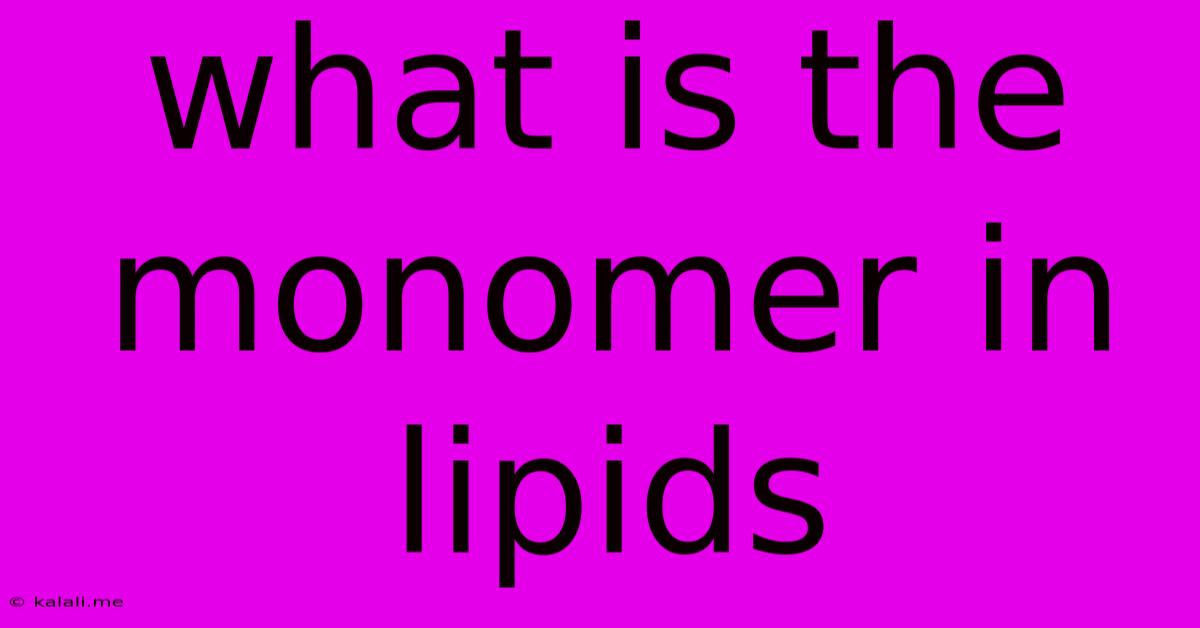What Is The Monomer In Lipids
Kalali
May 09, 2025 · 3 min read

Table of Contents
What is the Monomer in Lipids? Understanding the Building Blocks of Fats
Lipids are a diverse group of biological molecules that are largely hydrophobic, meaning they don't dissolve easily in water. Unlike carbohydrates and proteins, which have single monomer units (monosaccharides and amino acids respectively), lipids don't have a single, universally applicable monomer. Instead, their structure is more complex and varied, leading to different classifications and building blocks. This article will explore the components that constitute lipids and clarify the concept of "monomers" in this context.
The Building Blocks: Not a Single Monomer, but Several Key Components
The term "monomer" typically refers to a small, repeating unit that joins together to form a larger polymer. While lipids are indeed macromolecules, they are not built from a single type of repeating monomer in the same way that proteins are built from amino acids. Instead, lipids are constructed from a variety of smaller molecules, depending on their specific type. These key components include:
-
Fatty Acids: These are long chains of hydrocarbons with a carboxyl group (-COOH) at one end. Fatty acids are the most fundamental building blocks of many lipids. They vary in length and the degree of saturation (presence of double bonds). Saturated fatty acids have no double bonds, while unsaturated fatty acids contain one or more double bonds. The properties of a lipid are heavily influenced by the types of fatty acids it contains. This includes factors like melting point and fluidity.
-
Glycerol: This is a three-carbon alcohol that forms the backbone of many lipids, including triglycerides and phospholipids. Glycerol acts as a connecting point for fatty acids. Understanding its role is crucial for grasping lipid structure.
-
Phosphate Groups: These are found in phospholipids, a crucial component of cell membranes. The phosphate group is hydrophilic (water-loving), in contrast to the hydrophobic fatty acid tails. This amphipathic nature of phospholipids allows them to form lipid bilayers, the foundation of cell membranes.
-
Other Components: Different lipids incorporate other molecules. For example, sterols like cholesterol contain a steroid nucleus instead of glycerol and fatty acids. These variations account for the functional diversity observed amongst lipids.
Types of Lipids and their Constituents:
To further clarify, let's examine some common types of lipids and their constituent parts:
-
Triglycerides: These are the most common type of lipid, consisting of a glycerol molecule bonded to three fatty acid molecules. The fatty acids can be the same or different.
-
Phospholipids: These are similar to triglycerides, but one fatty acid is replaced with a phosphate group, often linked to another polar molecule. This creates an amphipathic molecule crucial for cell membrane structure.
-
Steroids: These lipids are characterized by a four-ring carbon structure. Cholesterol is a prime example, playing a vital role in cell membrane fluidity and hormone synthesis.
Conclusion: A Nuance in Definition
In summary, lipids do not possess a single, universally applicable monomer like other macromolecules. Their construction involves various smaller molecules, primarily fatty acids and glycerol. Understanding the specific components and how they are assembled allows for a clearer grasp of the diversity and functionality of this crucial class of biological molecules. Focusing on the key components—fatty acids, glycerol, and phosphate groups (for phospholipids)—provides a more accurate and comprehensive understanding of lipid structure and function than searching for a singular "monomer."
Latest Posts
Latest Posts
-
How Much Is 30 Cm In Feet
May 10, 2025
-
Is 67 A Prime Or Composite
May 10, 2025
-
How Much Is 14 Grams In Ounces
May 10, 2025
-
What Is The Relationship Between The Environment And Phenotype
May 10, 2025
-
How Much Celsius Is 60 Fahrenheit
May 10, 2025
Related Post
Thank you for visiting our website which covers about What Is The Monomer In Lipids . We hope the information provided has been useful to you. Feel free to contact us if you have any questions or need further assistance. See you next time and don't miss to bookmark.